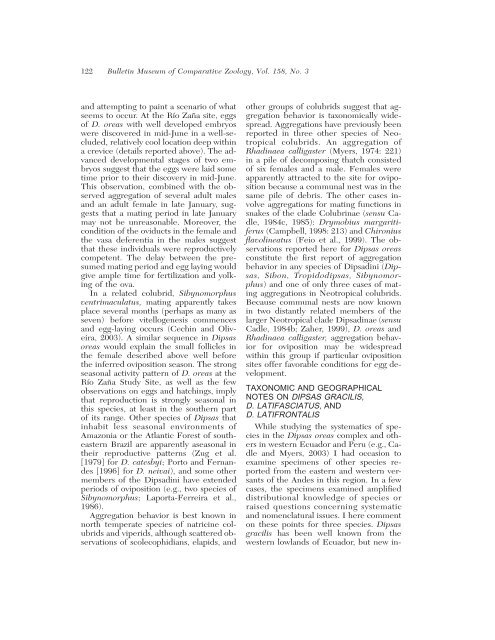systematics of snakes of the dipsas oreas complex - BioOne
systematics of snakes of the dipsas oreas complex - BioOne
systematics of snakes of the dipsas oreas complex - BioOne
Create successful ePaper yourself
Turn your PDF publications into a flip-book with our unique Google optimized e-Paper software.
122 Bulletin Museum <strong>of</strong> Comparative Zoology, Vol. 158, No. 3<br />
and attempting to paint a scenario <strong>of</strong> what<br />
seems to occur. At <strong>the</strong> Río Zaña site, eggs<br />
<strong>of</strong> D. <strong>oreas</strong> with well developed embryos<br />
were discovered in mid-June in a well-secluded,<br />
relatively cool location deep within<br />
a crevice (details reported above). The advanced<br />
developmental stages <strong>of</strong> two embryos<br />
suggest that <strong>the</strong> eggs were laid some<br />
time prior to <strong>the</strong>ir discovery in mid-June.<br />
This observation, combined with <strong>the</strong> observed<br />
aggregation <strong>of</strong> several adult males<br />
and an adult female in late January, suggests<br />
that a mating period in late January<br />
may not be unreasonable. Moreover, <strong>the</strong><br />
condition <strong>of</strong> <strong>the</strong> oviducts in <strong>the</strong> female and<br />
<strong>the</strong> vasa deferentia in <strong>the</strong> males suggest<br />
that <strong>the</strong>se individuals were reproductively<br />
competent. The delay between <strong>the</strong> presumed<br />
mating period and egg laying would<br />
give ample time for fertilization and yolking<br />
<strong>of</strong> <strong>the</strong> ova.<br />
In a related colubrid, Sibynomorphus<br />
ventrimaculatus, mating apparently takes<br />
place several months (perhaps as many as<br />
seven) before vitellogenesis commences<br />
and egg-laying occurs (Cechin and Oliveira,<br />
2003). A similar sequence in Dipsas<br />
<strong>oreas</strong> would explain <strong>the</strong> small follicles in<br />
<strong>the</strong> female described above well before<br />
<strong>the</strong> inferred oviposition season. The strong<br />
seasonal activity pattern <strong>of</strong> D. <strong>oreas</strong> at <strong>the</strong><br />
Río Zaña Study Site, as well as <strong>the</strong> few<br />
observations on eggs and hatchings, imply<br />
that reproduction is strongly seasonal in<br />
this species, at least in <strong>the</strong> sou<strong>the</strong>rn part<br />
<strong>of</strong> its range. O<strong>the</strong>r species <strong>of</strong> Dipsas that<br />
inhabit less seasonal environments <strong>of</strong><br />
Amazonia or <strong>the</strong> Atlantic Forest <strong>of</strong> sou<strong>the</strong>astern<br />
Brazil are apparently aseasonal in<br />
<strong>the</strong>ir reproductive patterns (Zug et al.<br />
[1979] for D. catesbyi; Porto and Fernandes<br />
[1996] for D. neivai), and some o<strong>the</strong>r<br />
members <strong>of</strong> <strong>the</strong> Dipsadini have extended<br />
periods <strong>of</strong> oviposition (e.g., two species <strong>of</strong><br />
Sibynomorphus; Laporta-Ferreira et al.,<br />
1986).<br />
Aggregation behavior is best known in<br />
north temperate species <strong>of</strong> natricine colubrids<br />
and viperids, although scattered observations<br />
<strong>of</strong> scolecophidians, elapids, and<br />
o<strong>the</strong>r groups <strong>of</strong> colubrids suggest that aggregation<br />
behavior is taxonomically widespread.<br />
Aggregations have previously been<br />
reported in three o<strong>the</strong>r species <strong>of</strong> Neotropical<br />
colubrids. An aggregation <strong>of</strong><br />
Rhadinaea calligaster (Myers, 1974: 221)<br />
in a pile <strong>of</strong> decomposing thatch consisted<br />
<strong>of</strong> six females and a male. Females were<br />
apparently attracted to <strong>the</strong> site for oviposition<br />
because a communal nest was in <strong>the</strong><br />
same pile <strong>of</strong> debris. The o<strong>the</strong>r cases involve<br />
aggregations for mating functions in<br />
<strong>snakes</strong> <strong>of</strong> <strong>the</strong> clade Colubrinae (sensu Cadle,<br />
1984c, 1985): Drymobius margaritiferus<br />
(Campbell, 1998: 213) and Chironius<br />
flavolineatus (Feio et al., 1999). The observations<br />
reported here for Dipsas <strong>oreas</strong><br />
constitute <strong>the</strong> first report <strong>of</strong> aggregation<br />
behavior in any species <strong>of</strong> Dipsadini (Dipsas,<br />
Sibon, Tropido<strong>dipsas</strong>, Sibynomorphus)<br />
and one <strong>of</strong> only three cases <strong>of</strong> mating<br />
aggregations in Neotropical colubrids.<br />
Because communal nests are now known<br />
in two distantly related members <strong>of</strong> <strong>the</strong><br />
larger Neotropical clade Dipsadinae (sensu<br />
Cadle, 1984b; Zaher, 1999), D. <strong>oreas</strong> and<br />
Rhadinaea calligaster, aggregation behavior<br />
for oviposition may be widespread<br />
within this group if particular oviposition<br />
sites <strong>of</strong>fer favorable conditions for egg development.<br />
TAXONOMIC AND GEOGRAPHICAL<br />
NOTES ON DIPSAS GRACILIS,<br />
D. LATIFASCIATUS, AND<br />
D. LATIFRONTALIS<br />
While studying <strong>the</strong> <strong>systematics</strong> <strong>of</strong> species<br />
in <strong>the</strong> Dipsas <strong>oreas</strong> <strong>complex</strong> and o<strong>the</strong>rs<br />
in western Ecuador and Peru (e.g., Cadle<br />
and Myers, 2003) I had occasion to<br />
examine specimens <strong>of</strong> o<strong>the</strong>r species reported<br />
from <strong>the</strong> eastern and western versants<br />
<strong>of</strong> <strong>the</strong> Andes in this region. In a few<br />
cases, <strong>the</strong> specimens examined amplified<br />
distributional knowledge <strong>of</strong> species or<br />
raised questions concerning systematic<br />
and nomenclatural issues. I here comment<br />
on <strong>the</strong>se points for three species. Dipsas<br />
gracilis has been well known from <strong>the</strong><br />
western lowlands <strong>of</strong> Ecuador, but new in-







